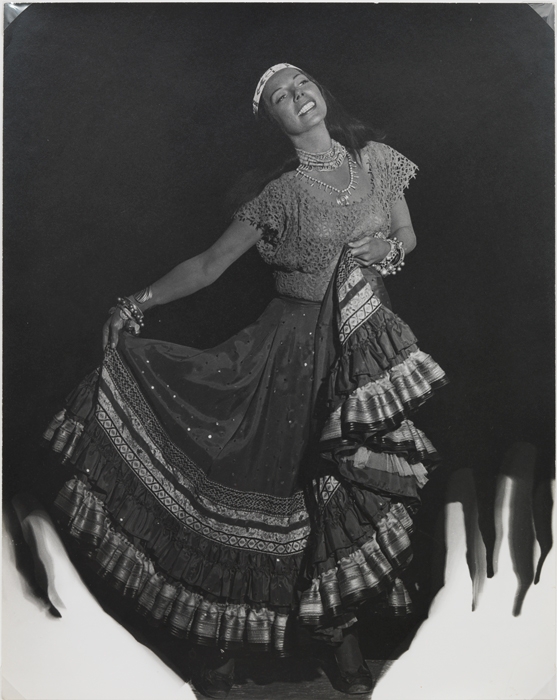There he is, in the corner of the room: a dark, malevolent presence, glowering at the camera from under heavy lids, his crazily crooked nose and uneven eyes lending the photograph a quasi-Cubist appearance. It was an intense look that Man Ray often assumed in self-portraits. (An alternative guise was that of the debonair dandy, smoking in sharply tailored suits beside a sporty automobile.)
Another notable thing about this 1943 photograph – the odd lynchpin of an otherwise outwardly conventional selection of photographs taken by the Surrealist during what was arguably the nadir of his career, his 11-year sojourn in Los Angeles after he fled occupied France – is that he only has half a beard. One side of his face is clean shaven, and the other framed by neatly clipped hair. How do you like me, he seems to ask? With? Without? I will be whatever you want me to be.
Except the problem was that he wouldn’t. Even though he adopted different personas throughout his career, Man Ray never played the role that Los Angeles had in mind for him – unlike fellow European émigrés such as Igor Stravinsky or Fritz Lang. Once he turned up to a meeting with film producers carrying reproductions of his paintings instead of his commercial fashion photography, telling them when asked if he wanted to be a special-effects man that he was more interested in being a ‘general effects man’. Hollywood was unimpressed, or unfamiliar, with Man Ray’s reputation, and he knew it.
Of the 27 small silver gelatin prints in this exhibition, most are studio portraits – an unrepresentative sample from Man Ray’s California output, given that he claimed to want to focus on painting rather than commercial photography and told his dealer Julien Levy soon after his arrival, in 1940, that he would no longer be taking portrait photographs. His resolve appears to have been shaky; the earliest portrait in the show, of Isamu Noguchi, is from the following year.
Why would Man Ray have given so much care and attention to the craft of portrait photography if he resented it so? Was it purely as a means to fund his ‘more creative work’ (his words) as it had during his years in Paris? Self-Portrait with Half Beard, as the 1943 photo is titled, was selected as the illustration for a diatribe the artist wrote that same year for View magazine, titled ‘Photography is Not Art’, in which he railed at the conservatism and obsession with technique of photography’s proponents. As in his self-portrait, however, Man Ray was divided. Ironically, many of the photographs in the exhibition, such as portraits of actresses Ava Gardner or Leslie Caron, both from 1950, or his untitled photographs of Los Angeles street scenes, do little to advance the medium beyond their technical proficiency.
Things get interesting, however, when Man Ray cuts loose in the darkroom. In a portrait of Tilly Losch, from 1946, the dancer lifts her gypsy skirt from a dark dripscape of developing fluid, which reveals the white paper beneath the exposure. Elsewhere Man Ray deploys his trademark solarisation technique (actually an inadvertent darkroom discovery by his lover Lee Miller, which he appropriated) to lend a pearlescent aura to a dreamy portrait of the model and actress Ruth Ford.
Ford, like Losch and other women Man Ray photographed, was not only a starlet but a peripheral member of his artistic circle (her brother was Charles Henri Ford, the Surrealist writer and editor of View). One gets – perhaps unsurprisingly – a rather sour taste of the sexism pervading the creative circles of the time, with women generally allowed only the supporting roles of sisters, wives, lovers or models, and then only on condition of their beauty. (Even the formidable and respected Dorothea Tanning, photographed here in 1948, also happened to be easy on the eye.) When Man Ray pictures the portly, slumping figures of Roberto Rossellini, Henri Langlois and Jean Renoir, by contrast, no solarisation is required.
The objectification of women is, admittedly, an easy issue to take with glamour photography of the 1940s and 50s, but in the photographic work of Man Ray it is especially obvious. Women look away demurely from the camera; men gaze squarely into the lens. (The beautiful and intimate photograph of Noguchi is a notable exception.) Man Ray had also, decades earlier, adopted the custom of posing his female models beside sculptures. In two photographs here, both from 1944, actresses Teresa Wright and Tamara Toumanova stand next to the pre-Columbian carved stone figures that were then in vogue, offering the viewer a chance to compare and contrast two modes of representation, and two forms of beauty.
Man Ray’s misogyny is hard to dodge, but his preoccupations here may have extended further than desire alone. In photographing these actresses (and the occasional actor), some famous names and others anonymous, he was reflecting on methods for constructing identity that he had also long applied to himself. In 1948 his old friend Marcel Duchamp visited him in LA from New York, and he contrived an apparently candid photograph of the pair sitting on a Parisian doorstep. The sign for the Rue de la vieille lanterne, however, is a fake; so is Man Ray’s depiction of himself as French. Born Emmanuel Radnitzky in Philadelphia, he was the son of Russian Jewish immigrants and an American citizen. There is no doubt that his inability to assimilate – still less flourish – in his native country was all the more painful because of this heritage. His 1948 exhibition at the Copley Galleries, in Beverly Hills, was sardonically titled To Be Continued Unnoticed, and in 1951 he set sail from New York to Paris, where he remained – better recognised – for the rest of his life.
11 January – 17 February 2018
From the March 2018 issue of ArtReview
